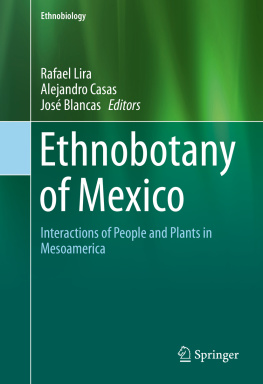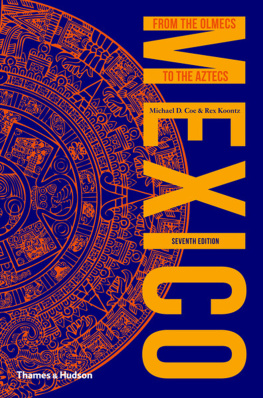Teotihuacan and Early Classic Mesoamerica
Multiscalar Perspectives on Power, Identity, and Interregional Relations
edited by
Claudia Garca-Des Lauriers and Tatsuya Murakami
U NIVERSITY P RESS OF C OLORADO
Louisville
2021 by University Press of Colorado
Published by University Press of Colorado
245 Century Circle, Suite 202
Louisville, Colorado 80027
All rights reserved

The University Press of Colorado is a proud member of the Association of University Presses.
The University Press of Colorado is a cooperative publishing enterprise supported, in part, by Adams State University, Colorado State University, Fort Lewis College, Metropolitan State University of Denver, Regis University, University of Colorado, University of Northern Colorado, University of Wyoming, Utah State University, and Western Colorado University.
ISBN: 978-1-64642-220-3 (hardcover)
ISBN: 978-1-64642-221-0 (ebook)
https://doi.org/10.5876/9781646422210
Library of Congress Cataloging-in-Publication Data
Names: Garca-Des Lauriers, Claudia, 1976 editor. | Murakami, Tatsuya, editor.
Title: Teotihuacan and Early Classic Mesoamerica : multi-scalar perspectives on power, identity, and interregional relations / edited by Claudia Garca-Des Lauriers and Tatsuya Murakami.
Description: Louisville, CO : University Press of Colorado, [2021] | Includes bibliographical references and index.
Identifiers: LCCN 2021034809 (print) | LCCN 2021034810 (ebook) | ISBN 9781646422203 (hardcover) | ISBN 9781646422210 (ebook)
Subjects: LCSH: Indians of MexicoSocial conditions. | Indians of Central AmericaSocial conditions. | Indians of MexicoCommerce. | Indians of Central AmericaCommerce. | Indians of MexicoPolitics and government. | Indians of Central AmericaPolitics and government. | Indians of MexicoAntiquities. | Indians of Central AmericaAntiquities. | Antiquities, PrehistoricMexico. | Antiquities, PrehistoricCentral America. | Social archaeologyMexico. | Social archaeologyCentral America. | MexicoRelationsCentral America. | Central AmericaRelationsMexico.
Classification: LCC F1219.3.S57 T43 2021 (print) | LCC F1219.3.S57 (ebook) | DDC 972/.016dc23
LC record available at https://lccn.loc.gov/2021034809
LC ebook record available at https://lccn.loc.gov/2021034810
The University Press of Colorado gratefully acknowledges the support of Tulane University and California State Polytechnic University, Pomona toward this publication.
Front-cover photograph by Ramiro Valencia. Back-cover and spine photograph, courtesy, Carlos Viramontes
To George Cowgill, who mentored and inspired us
To Matthew, Emilio, & Yoshiko, who love and support us
Contents
Tatsuya Murakami and Claudia Garca-Des Lauriers
Tatsuya Murakami
Sergio Gmez Chvez and Julie Gazzola
Sarah C. Clayton
Haley Holt Mehta
Patricia Plunket and Gabriela Uruuela
Yoko Sugiura, Carmen Prez, and Gustavo Jaimes Vences
Juan Carlos Saint-Charles Zetina and Fiorella Fenoglio Limn
Agapi Filini
Claudia Garca-Des Lauriers
Claudia Garca-Des Lauriers
The origins of this book go back to 2013 and a session organized by the editors titled Teotihuacan and Early Classic Mesoamerica: Multi-Scalar Perspectives on Power, Identity, and Interregional Relations for the Society for American Archaeology 78th Annual Meeting in Honolulu, Hawaii. Our goal in this session and in this book is to embrace the theme of Teotihuacan influence abroad from a Mesoamericanist perspectivean idea that George Cowgill first suggested in 2003. Much of the discourse on this topic has been broached from evidence found in the Maya region, but when we step back and look at the broader context of Early Classic Mesoamerica we see a complex landscape of interactions visible at different scales and representative of many different kinds of relationships. The chapters in this book are an important contribution to this dialogue. In the years since the organized session and the completion of this manuscript we lost some contributors; however, we want to acknowledge their participation. Thank you to David Freidel, Olivia Navarro Farr, and Michelle Rich, who were part of the original symposium. Barbara Stark and Kenneth G. Hirth served as discussants for the session, and their original comments were integrated into the final contributions presented here. We are grateful for their mentorship and support. In addition to these important scholars, we also want to thank George Cowgill, who passed away before this book was published but whose ideas greatly inspired the organized session and this book. He is greatly missed not only for his incredible intellect and contributions to archaeology, but because he was also an immensely kind and generous human being who played a life-changing role in each of our careers. We are incredibly grateful to all of the contributors to this volume for their patience with us as editors and for their incredible contributions.
Along with these important colleagues, we would also like to thank several institutions that have supported our research. Among them, we thank California State Polytechnic University, Pomona, and Tulane Universityour home campusesfor their institutional support. Tulane University, Cal Poly Pomona College of Letters, Arts, and Social Sciences, Department of Geography and Anthropology and Kellogg Honors College contributed financial support for this publication. The Department of Anthropology at Tulane University and Marcello Canuto, director of the Middle American Research Institute (MARI) were also incredibly supportive of this project. In addition, the University Press of Colorado publishing team, especially Charlotte Steinhardt and Darrin Pratt and two anonymous reviewers, were essential to getting this book to press.
Finally, we would like to thank our families for their incredible patience, love, and support. Emilio, Matthew, and Yoshiko: this project would not have come to completion without your hugs and encouragement.
Introduction
Teotihuacan and Early Classic Mesoamerica
Tatsuya Murakami and Claudia Garca-Des Lauriers
The Early Classic period (ca. AD 200/300600) has been characterized by the appearance of Teotihuacan-related material culture throughout Mesoamerica (figures 1.11.3), variously termed in the literature as a Middle Classic Horizon, or more often referred to as Teotihuacan influence (Braswell 2003a; Demarest and Foias 1993; Pasztory 1978; Stuart 2000). The question of what this so-called influence represents has largely been taken up by scholars working in the Maya region, where beginning in the late 1940s with the research of Kidder et al. (1946) they turned up evidence of contacts between Kaminaljuy and Teotihuacan. Since then there has been much ink spilt attempting to sort out the relationship between several important centers in the Maya region and the great Central Mexican metropolis. Recent iterations of this debate include Geoffrey Braswell (2003b); David Stuart (2000); William Fash and Barbara Fash (2000); Ellen E. Bell et al. (2004); and Jesper Nielsen (2003) among others, who again retake these questions with a focus on the Maya region. However, as George Cowgill (2003a:324) pointed out, while the interactions between the Maya and Teotihuacan have received the lions share of the scholarly attention, they are simply the farthest southeastern expressions of strong Teotihuacan influences and that Teotihuacan presences of various kinds were widespread in Mesoamerica. Cowgill (2003a:324) further notes that a book on the general theme of Teotihuacan abroad is necessary to add to this important dialogue.








 The University Press of Colorado is a proud member of the Association of University Presses.
The University Press of Colorado is a proud member of the Association of University Presses.